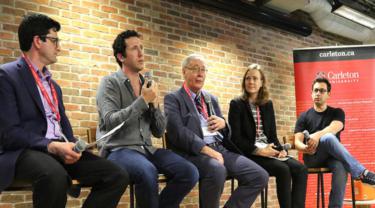‘If you think about Canada’s place, it’s not about building cool new software, it’s about how do we make our mining companies 10 times more efficient? No one in Silicon Valley is doing that.’
The first time Globe and Mail technology reporter Sean Silcoff wrote about technology was a full 19 years ago. It was a time when, as he explains it, the web was brand new, Google was a science project at Stanford, and Facebook founder Mark Zuckerberg was 14 years old.
“There were no smart phones and Kitchener-Waterloo was a dumpy blue-collar region whose best days seemed behind it,” said Silcoff, who recently chaired a panel organized by the Carleton Initiative for parliamentary and diplomatic engagement and held at Shopify’s Ottawa headquarters. It was titled “Building a Global Tech Hub North of 49.”
He talked about how disruptive technology has become, but also how much opportunity there is.
“The good news is that we have a teeming technology sector, not just in the big centres, but we’ve seen some very successful startups from St. John’s to Victoria, Kelowna, Fredericton, Quebec City,” he said. “They’re backing each other and helping to grow the ecosystem.”
Silcoff quipped that those companies obviously didn’t get the memo that Canadians are “weak competitors” or that they “lack entrepreneurial fire”— statements from government reports, blue-ribbon panels, and even by Order of Canada recipients.
That said, even Canada’s tech giants are small. It would cost only $93 billion to buy every publicly traded tech company in Canada. “That’s one sixth the size of Amazon or equal to one quarter of the cash investments Apple has on its balance sheet,” he said.
Silcoff launched the discussion by asking panelists to define innovation. The consensus was that it’s an idea that generates revenue. Too often invention gets confused for innovation — and leaves out the essential component of making money from the idea.
What follows is an edited sampling of questions, answers and ideas shared by the panelists.
Silcoff: If we’re pushing to create innovation, what does that look like in practice?
Daniel Debow, co-founder of Helpful.com, Rypple, Workbrain and 2015 Canadian Angel Investor of the Year: It’s a big question. I think if we’re being honest about having an innovative society, we have to change some things we take for granted. When we protect significant amounts of our economy from competition — banks, airlines, cable, film and agriculture industries — that adds up to less innovation.
Harley Finkelstein, COO of Shopify and 2017 Canadian Angel Investor of the Year: We’ve created about 75 millionaires at Shopify and many are paying it forward by reinvesting in other companies. When I came here in 2005, I spent some time with some of the old guard from telecom companies and it didn’t seem as though they paid it forward in the same way.
Silcoff: We’re talking about saying that to create a successful society, we need to create more wealth. How will this resonate with Canadians?
Janet Bannister, general partner at Real Ventures and founder of Kijiji: Great companies create a vibrant economy. The biggest risk is robots and electronics taking away the jobs of underskilled people, for instance truck drivers. What happens when you have self-driving trucks? That’s where the danger to society lies.
Debow: The goal is not to create millionaires, but [we must] recognize when making public policy that that is an intended side effect and positive externalities occur as a result. When you made money in Boston, you competed to get your name on a hospital or museum. Many in Toronto did the same. In Silicon Valley, you compete on which hot startup you’ve invested in, which is a much more dynamic thing. If you create a public policy context where entrepreneurs’ success is viewed as failure for everyone else, that’s not a positive outcome for our economy.
Finkelstein: There’s historically been a lack of role models in this country — a lack of people like Daniel [Debow] who made a lot of money and reinvested it. We have more role models today. For a long time, we had Nortel and Blackberry and those, unfortunately, aren’t very good role models.
Bannister: I remember being in Silicon Valley where, if you sold out too early, people would ask what you were doing. In Canada, if you didn’t take that first offer, you were crazy. But I think that’s shifting. Ten years ago in Canada, success was making a couple million dollars, buying a cottage, and calling it quits. Today, entrepreneurs want to create a lasting company, a legacy, and jobs in Canada.
Silcoff: [Professor Bailetti,] can you talk about having a front-row seat on the rise and fall of Nortel?
Tony Bailetti, director of Carleton’s Technology Innovation Management Program and an associate professor:The whole confluence between data and voice — we missed it totally. We were a voice company and we could do data. For us, it would be a platform with some data on top, but the hard part was the voice. What happened with Nortel, [is that people] didn’t want to leave Ottawa. It was a bad thing for Nortel to disappear, but it was also a great thing. It’s made this region a lot stronger. Ottawa is booming as a city of innovation and entrepreneurship in a way I haven’t seen in 40 years. When big companies die, the people with the resilience and the will do rebuild the economy.
Debow: What you want instead of a monoculture of one giant company is a hyper-competitive diverse economy where people are stealing talent, pulling out of the big companies, taking money from big companies and starting new ones. That’s a good thing.
Silcoff: Is there a hazard to pushing too many people into the field? A lot of you are entrepreneurs. What’s it like? Is there glamour?
Bannister: Definitely not. Entrepreneurs work incredibly hard under very stressful conditions and most of them don’t make it. A typical entrepreneur does everything from payroll, writing code, making sales calls, and arranging who will take the garbage out. The rewards can be great, but it’s definitely not for everybody.
Finkelstein: But one thing has changed dramatically and that’s the cost of failure. In 2017, the cost of failure is trending as close to zero as it’s ever been. Never in history have things been this inexpensive.
Silcoff: We’re seeing lots of [innovation] programs. Where is government getting innovation right?
Bannister: A lot of the funding programs government is doing are right. They’ve been putting a lot into artificial intelligence (AI), which is critical. People educated in Canada are leading and heavily involved in AI paths at Google and Facebook. Keeping AI here is terrific. Some of the money going into the entrepreneurial ecosystem is terrific. In terms of improvement, sometimes I worry about which companies are getting the money. It’s needed, but government isn’t necessarily best [suited] to be deciding who gets it.
Finkelstein: One thing that does feel different is that there seems to be a lot more listening than there has been in the past. [Government officials are] actually asking how they can be most helpful. There are things that are really important to us, such as stock option taxation. If it weren’t for the tax treatment of stock options, Shopify would not exist today. Or immigration: We need skilled workers. Those conversations are happening now, but weren’t a few years ago. Where we could do a better job as the tech community is by spending the time with policy makers to explain [our needs.]
We also need to empower government with some [public relations] to sell the [tech] story. When a foreign company opens here and government officials attend, that’s a little ridiculous. Someone working in a warehouse is very different from an engineer working at Shopify. It’s on us to better communicate to government. I’m spending a lot of time on this now.
Debow: I would say the most important thing that this government has done on innovation is talk about it.
Bailetti: I think anything the government does that [prompts entrepreneurs to confuse] government grants with revenue from customers is a real bad thing. If I start thinking that all I need to do is fill out forms for IRAP [Industrial Research Assistance Program] and I don’t have to think about customers, that’s a bad thing.
Second, politicians often compare the jobs created by investing in entrepreneurs with those created by supporting big companies. The [fear] is that if we don’t put a lot of money into these large companies, they’ll lay off a bunch of people. That’s a real bad trade off. Taking away from a few entrepreneurial spirits to support bigger companies is the wrong call.
Finally, on the global scene, the Israelis, the [Americans], the Japanese are doing a bang-up job from a government perspective of supporting entrepreneurs. We could do better.
Debow: We should think more broadly. What’s really changed is that the internet is hitting every sector, every part of our economy. If you think about Canada’s place, it’s not about building cool new software, it’s about how do we make our mining companies, our agriculture, our fishing industries 10 times more efficient? No one in Silicon Valley is doing that. We have that opportunity.
Silcoff: Does the difference between taxes, say, in Ontario versus Silicon Valley ever come up?
Debow: I’ve never heard [would-be] entrepreneurs talk about corporate tax rates. The decision is almost always about access to capital and talent and quality of life. The individual tax rate makes a difference. They don’t often talk about it, but many of them have said they’ve left because they can make more money [in Silicon Valley].
Finkelstein: Capital gains taxation, the way it’s done in Canada, is great. I invested recently in a company called Skip the Dishes. Because the investment was taxed as capital gains, the profit I got allowed me to invest in three other companies, rather than two. [Individually,] no one wants to pay 52 per cent taxes, but that’s a rich person’s problem.
In 2011, when Shopify couldn’t pay big salaries, we offered stock options instead. We brought in experts to show [prospective employees] how they would ultimately make more money. That’s how we got people for $130,000 versus $220,000. In many cases, it was the difference between them being a millionaire and not being a millionaire.
Photo by Mike Pinder






